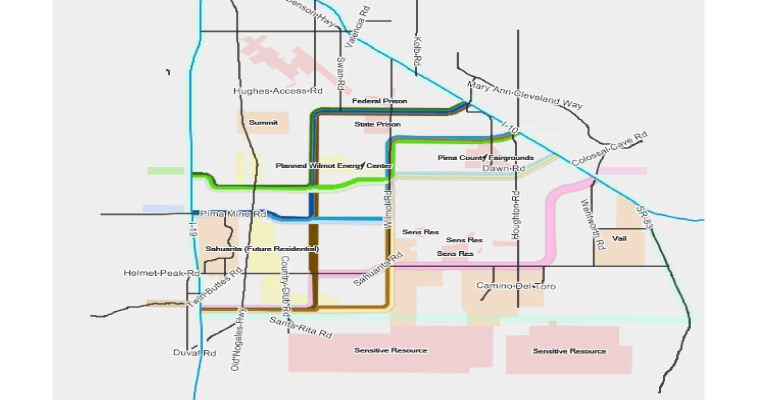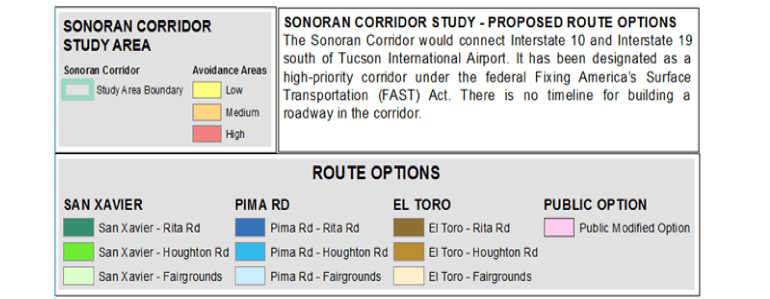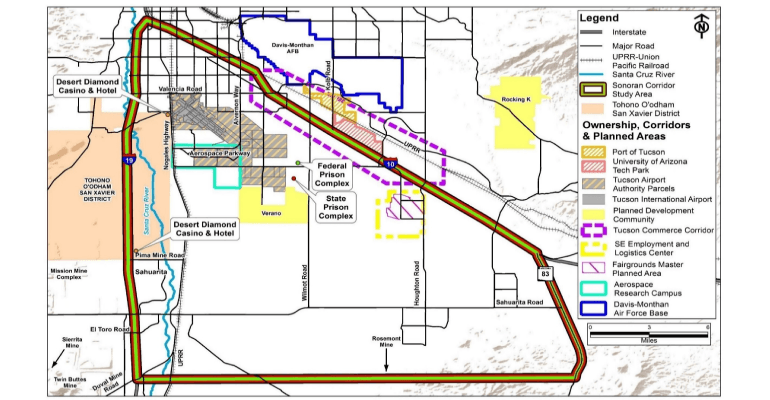The Arizona Dept. of Transportation/Federal Highway Administration (ADOT/FHWA) map of potential Sonoran Corridor routes was unveiled at a public meeting of about 100 people held September 26 at the Desert Diamond Casino.


The format for the meeting was an introduction by Project Manager Carlos Lopez, a slide show describing the Tier One Environmental Impact Study (EIS) and potential routes, and some generalized reasons for building the highway linking I-19 and I-10 south of Tucson International Airport. That was followed by one-on-one conversations with over a dozen staff members present. It was clearly meant to be a smiley-face, feel-good kind of meeting, but there were a few potholes in the road.
After Lopez finished his introduction, one audience member rose to ask a question, breaking the ADOT meeting formula. The question was, given the Pima County Board of Supervisors’ Resolution 2007-343 opposing any new bypass, and given that voters rejected the Sonoran Corridor in the 2015 bond election, how is it that the project is proceeding?
Lopez replied that would be answered at the end of the presentation. Another audience member, with vocal support from still others, said quite loudly that, “We all want to hear the answer to that one.”
Lopez cited anticipated growth, economic development, regional mobility, future travel demand, reduced commercial and commuter travel time, increased population. He said that meetings with public agencies focused on the movement of freight and commerce, promoting economic development and reducing travel time. He added that ADOT was collaborating with the Tohono O’odham Nation’s San Xavier District. The only concrete reason given for a new highway was to allow airport access from the south.
He showed a map with ten potential corridors to be analyzed for the EIS, but failed to mention the No-Build alternative that would cancel the project. An audience member asked about this and the Project Manager hastily added that there was always that option, but that they were looking at the “most reasonable alternatives”.
The late Senator John McCain, with bipartisan support from Arizona legislators, amended the 2015 FAST Act, a transportation bill, to designate the Sonoran Corridor as high-priority. No funding was provided, however, and there is no public timeline for actual construction. Decisions made by the EIS Study, however, will be the model when money does become available.
The Avra Valley I-11 Connection
Following Lopez’s presentation and slide show, I-11 Project Manager Jay Van Echo, who serves as an “advisor” to the Sonoran Corridor EIS answered for Lopez about overturning the Supervisors’ resolution and voter rejection. Obviously angry at the violation of ADOT’s no-questions/no comments meeting format, Van Echo said that would be addressed in the final EIS report in February 2019. Period. End of discussion.
Citizens for Picture Rocks, a long-standing community group in the Avra Valley, has asked District 3 Supervisor Sharon Bronson to place re-certification of BOS Resolution 2007-343 opposing any new highways in the county on an early agenda for action by the Board. Bronson has, to date, not responded.
Van Echo’s looming presence, and Lopez’s fact-free presentation, made it clear to those following the projects that there was no reason to build a Sonoran Corridor without also building an Avra Valley I-11. It was also clear that the EIS intends to bring in a recommendation for a new highway, and as Pima County Administrator Charles Huckelberry proposed over five years ago, one that links to an Avra Valley I-11.
ADOT’s May 2018 Purpose and Need Memorandum provides confirmation, and clearly indicates that the impetus for the study came from Pima County. They note that the present I-11 study now in its third year “is evaluating potential connections for a future interstate highway in central and southern Arizona; Corridor options could become part of the interstate system that will affect how the Sonoran Corridor links to I-19.” Meaning, to hook up with I-11 at I-19 as originally proposed by Huckelberry.
An ADOT representative confirmed that the expected January public meetings on their recommended alternative for I-11 – a choice between the Avra Valley, the existing I-10 corridor, or No-Build – would honor the commitment Van Echo made in August at the Citizens for Picture Rocks meeting – that the public meeting would be an open and free discussion. She said they were still working on times and places to attract the most people.
To view the Sonoran Corridor alternatives and documents, and to comment, go to https://azdot.gov/planning/transportation-studies/sonoran-corridor-tier-1-environmental-impact-statement/overview. You can also comment by email: sonorancorridor@adot.com; by snail mail: Sonoran Corridor Tier 1 EIS Study Team, c/o Joanna Bradley, 1221 S. Second Avenue, Mail Drop T100, Tucson, AZ 85713; and by toll-free bi-lingual phone: 1-855-712-8530.
The Diamond Ventures Connection
South Wilmot Land Investors, organized and staffed by Diamond Ventures, drafted its Specific Plan for Swan Southlands in 2005 with amendments in 2010. The 3200 acre development notes that, “There are regional plans to develop an Aerospace, Defense, High Tech and Manufacturing Business Park in the southeast area. This was initiated with the development of the Aerospace Parkway to serve Raytheon and the Tucson International Airport. The alignment of a future regional transportation corridor connecting I-19 to I-10 is also planned.” That was written at least ten years before the ADOT/FHWA study began, and four years before the Pima County Administrator went public with his plan.

The yellow space labeled “Verano” west of Wilmot Road is the Diamond Ventures planned Swan Southlands development. Why the only other named spaces are two prisons and Desert Diamond Casino are a mystery. Don Diamond has sold a lot of land to Pima County over the years, served on Republican Wilford Cardon’s unsuccessful 2014 primary campaign for Arizona Secretary of State, and raised tens of thousands of dollars, in addition to his own direct donations, to re-elect Democrat District 3 Supervisor Sharon Bronson in 2016.
Comparing the two ADOT/FHWA maps, it is clear that five of the ten Sonoran Corridor alternatives would serve as taxpayer-paid access highways for the Swan Southlands development. Yet ADOT staff at the public meeting answering questions about the maps they had laid out claimed to know nothing about any Swan Southlands project or Diamond Ventures interest in a Sonoran Corridor.
Millions of taxpayer dollars are being spent on these ADOT/FHWA studies with most people believing that the outcome – an Avra Valley Interstate 11 connecting at I-19 to a Sonoran Corridor – is a done deal. But there has been an outpouring of opposition, with comments possibly setting an ADOT record. I-11, and its Sonoran Corridor extension, are a test of the peoples’ will versus crony politics.
